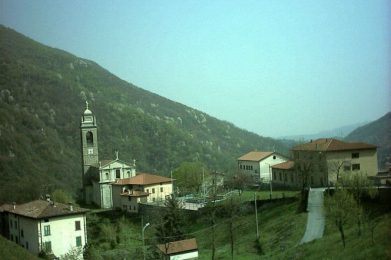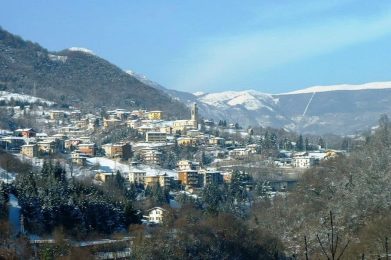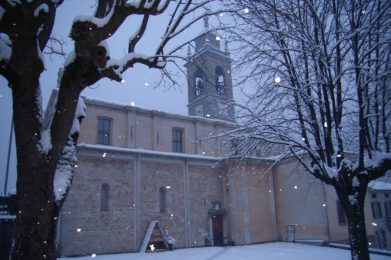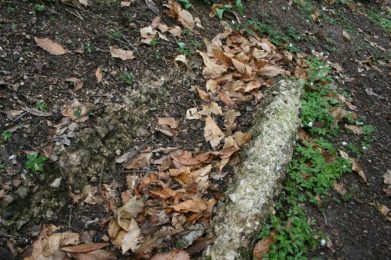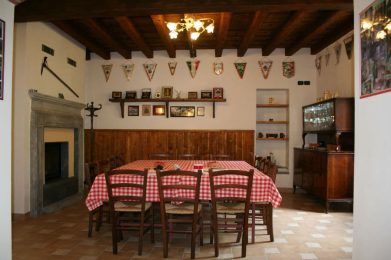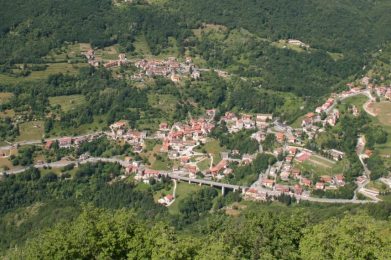Strozza is the first town at the mouth of the Imagna valley, placed as a “sentinel” of the naturalistic treasures that the valley contains. In the inhabited center you can still admire numerous buildings dating back to medieval times, including some fortified houses complete with a tower, but also very characteristic districts and rustic buildings.
Immagini del borgo
The first signs of human presence in the territory of Strozza date back to the Roman Age, as documented by the discovery of an aqueduct located on the slopes of Monte Albenza, situated on the orographic right side of the country. However dates back approximately to the year 1000 the origins of the village, placed at the entrance to the valley. Here the mountains are approaching considerably by creating a choke, then open in what is the Imagna valley. From this situation then derives the toponym throttles. Is in the medieval era that country begins to assume a physiognomy precise, although in previous centuries there were some settlements scattered.
In that period in the zone imperversarono bloody clashes, much more than in other areas of the province of Bergamo, between Guelphs and Ghibellines. This due to the fact that the valle Imagna, predominantly Guelfa, was in sharp contrast with the adjacent Brembilla Valley, siding with the Ghibellines. In the whole area arose castles and fortifications and choking was not less: in this regard there are some remains of buildings, among which stand out tower-houses and fortified centers dating back to a period between the XII and XIII century. The first clashes saw prevail the Guelfs, so much so that the Ghibellines asked aid to the Visconti family, lords of Milan. These managed to defeat their opponents and to extend its dominance over the valleys of the area. The way in which infierirono on opponents brought the Guelphs to seek more times the revenge with more murders.
After continuous tipping over in front of the domain of the Visconti and Ghibellines was final, even if the grudge guelfo gave often followed a popular revolts, often suffocated with weapons. The situation was overthrown when the area passed under the control of the Republic of Venice, which in contrast with the Visconti, claimed the deployment guelfo. Followed destruction in respect of the possessions of the Ghibellines, while countries Guelfi, between which throttles, had a favorable treatment.
The first village at the entrance of the valle Imagna, choking place to “sentinel ” of naturalistic treasures that the Valley preserves. The name derives from the particular morphology of the valley, marked by the Imagna torrent, which separates the two slopes in this final section, where you inforra for about two kilometers before flowing into the river Brembo, Clanezzo. In hydraulic left the Ripa steep halls all in one breath up to the top of Monte Ubione. There are no settlements, the slope is covered by a dense forest, at the base of which winds the “Trail Of Chitò” that, starting from Clanezzo, travels along a disused hydroelectric channel for then climb over the Imagna in proximity of choking with a hardy channel bridge in stone. The Trail of the recent reconfiguration travels along sections of particular naturalistic interest with encrusting sources with deposit phenomena concrezionale, rare for the bergamasca. The slope in hydrographic right is more acclive and allows the settlement of choking with the districts of Ca’ Brozzo and Ca’ field and with the fraction of Amagno.
In the town you can still admire the several buildings dating back to the medieval era, including some fortified houses with much of the tower, but also contrade very characteristics and constructions in rustic style. In the religious context is of great importance in the parish church of Sant’Andrea. Already mentioned in documents dating back to the XIV century, but rebuilt in the XVIII century and further restructured in subsequent centuries. During one of these restructuring has emerged the masonry of the southern wall of the fifteenth-century structure with two single lancet trefoil arch. Inside remarkable are the gold inlay present in the high altar and the choir, as well as the component of the production of the family Serassi.
Ca’ Campo
a handful of narrow houses around the small oratory in San Pantaleone, almost in its defense. Cà field was never isolated thanks to the network of mule tracks, which here form a crossroads. There is transited to enter and exit from the valley. Visit Ca’ Campo, stroll through its narrow lanes repays the short time dedicated to it. The suggestion is strong: medieval angles intact, stone portals, balconies and wooden houses and towers; finally the fifteenth-century oratory of San Pantaleone valuable work of faith in the cult of the statue of San Momà, the patron saint of childbirth without milk.
Amagno
along the main street, which flanks the parish church, after a few hundred meters you enter in the medieval village of Amagno. At the entrance you are greeted by the severe facade of the house of the family Gavazzeni de Gaiboni: continuing to reach in the piazzetta del washboard dominated from the eastern facade of CÃ del Maestro with the main access door and the wide windowed of New Museum Valdimagnino. To discover the most suggestive part of Amagno must forward on to the entrance hall, which sottopassa the CÃ del Maestro: here there is the true heart of the village, a small square paved in stone on which overlook historical buildings like an austere and elegant house medieval tower and the secentesca CÃ del Maestro. This palazzetto, restored to its original architectures, offers on the ground floor a portico with two large arches supported by a powerful central pillar, and on the first floor a loggia supported by a series of elegant columns.
On the bottom of the piazzetta, protected by a railing, there is the hatch of the freezer. Before “The Icebox” was open to the public, few knew the secret, which hided the CÃ del Maestro: an underground conduit dipartiva from one of the premises, located on the street side, led to a compartment of cylindrical shape with cover to time, used as a freezer. It is a splendid structure remained intact despite having a couple of centuries or perhaps more. On the vault is visible the opening with the hatch, from which in the winter months was introduced the snow. The Valdimagnino Museum occupies the two premises are located in front of the trench duct, which leads to the freezer. After a recent restoration now hosts many objects of the past valdimagnino. Very interesting the fireplace with “nicia”, discovered after the demolition of a wall, that the hid. Sitting in the niche is Pierino, the ghost of the ice house! In the visits made by the pupils of some elementary schools of the Imagna Valley to the Museum Valdimagnino, children are fond of this particular grandfather, which provides to treat the objects kept in the museum.
Village of Strozza
Municipality of Strozza
Province of Bergamo
Lombardy Region
Population: 1.080 strozzensi
Altitude centre: 378 m s.l.m.
the Municipality is part:
Comunità Montana Valle Imagna
Municipality
Via Roma 7 – Tel. +39 035 863180
BY CAR
- Along the highway the closest exits to the center of Strozza are:
– Bergamo exit (A4 Turin-Trieste)
– Dalmine exit (A4 Turin-Trieste)
– Treviglio exit (A35 Brescia-Milan)
– Caravaggio exit (A35 Brescia-Milan)
ON THE TRAIN
- Ponte S.Pietro station
- Cisano Caprino Bergamasco station
BY PLANE
- Bergamo Orio al Serio airport
- Milan Linate Airport
- Milan-Malpensa airport

